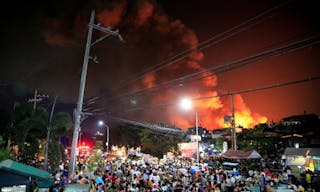What you need to know
'Someone wanted them to happen, someone stands to profit, and hardly anybody is talking about it.'
These events are probably unrelated. No single person or group engineered the entire thing. But suspicions remain and there are similarities between them that can’t be ignored. Someone wanted them to happen, someone stands to profit, and hardly anybody is talking about it.
Since late December 2016, there have been nine major fires in Metro Manila’s slum areas and informal settlements. Another massive fire hit a factory in Cavite, just outside Manila, a few weeks ago. In the country’s coldest months, fires have broken out and ravaged thousands of households. Somebody stands to gain from all of this while most of the residents are left reeling as they scamper in evacuation centers or the gutters.
Worse, the thousands of workers in Cavite still have to go to work. The death toll has been muddled by media reports despite the fact it was one of longest fires in recent memory. It lasted for almost 48 hours before firefighters and even the public were able to get a grasp on it. This wasn’t a community, but thousands of workers lived inside the premises. Independent investigations are still on-going.
Let it burn
I was able to learn directly about some of the fires in recent months. The first occurred on Dec. 28, 2016, on NIA Road in Quezon City, Metro Manila. Around 500 homes were razed to the ground, affecting 1,000 families. Residents said the fire started in a home that was empty at the time.
The people of NIA Road have long been a target of demolition by the local government. As part of the Central Business District project that went into full gear in 2008, a total of 22 barangays (towns) in the vicinity have been pegged for evictions. Violent encounters between demolition teams, riot police and the barricading residents have broken out a few times over the years.
The CBD project is a 65 million Philippine Peso (US$1.2 million) joint venture between the local government, the National Housing Authority and the Ayala Land Corporation. They have periodically pointed out the presence of poor settlers as the main hindrances to commercial development.
Unsurprisingly, Mayor Herbert Bautista’s immediate response to the fire victims was that they should be relocated immediately. This prompted locals to say, “There wasn’t any demolition, but you tried to burn us alive.” This is something the nearby town of San Roque, another CBD target, has dealt with a few times over the years.
On Jan. 10, more than 1,200 families were left homeless by the flames that engulfed the Navotas Fish Port. The area has also been eyed for the Port Modernization project, another joint venture. These are part of the Public-Private Partnership (PPP) trend in economic management that seeks to transform public lands and assets into corporate or privately-run firms.
Residents said that the nearby gas station was without any supply in the three days leading up to the incident. Again, the fire supposedly started in an empty house, but investigations proved inconclusive. According to the locals, those who were not affected by the fire are being intimidated into leaving the area.
Relocation is often a feared prospect for urban poor Filipinos. Resettlement areas are usually without proper sanitation, electricity, public facilities, and most of all, are far from any sort of employment or livelihood. These are communities erected in the middle of nowhere by another joint venture. The people who live in these places are expected to pay the high cost of amortization, despite the communities being “socialized housing projects.”
Two days later, a protest/barricade kicked off in Navotas and government agencies were forced to declare the area as fit for rebuilding. Although the Port Modernization project still looms.
On Feb. 8, the people of Catmon, Malabon City were once again stricken by catastrophe. For nearly a decade, Catmon has been pegged for demolition to make way for road-widening projects. Constant harassment and intimidation have met the citizens who have resisted. Erning Gulfo, a community leader, was assassinated in his own home in 2012.
No form of consultation has ever taken place. People say that, at most, there have been under-the-table agreements with a certain General Aglipay who owns part of the land, but these have never come to fruition. The Catmon fire left 5,000 homeless and five people severely injured.
On the same day, another fire burst through in Parola, Manila, displacing about 3,200 families.
Like Catmon, Parola is also pegged for demolition to make way for a road-widening project under the Manila North Harbor Development plan, another huge PPP undertaking by the Manila City Hall.
“Fire, water and government know nothing of mercy”
These similarities have all been neglected by news reports on the fires. Another aspect left out is all these areas, and some others, are home to political organizing conducted by progressive groups in the country. This is why the efforts at demolition and eviction have been pushed back through the years.
Coincidentally, March is Fire Prevention Month. It’s almost as if these fires have stopped just in time for the annual series of fire drills and safety seminars.
I would not go so far as to say that these fires were all deliberately started and the same people are behind it. Though inhabitants of the mentioned communities certainly feel that way, the evidence is lacking. What is alarming is how both the state and its business partners seem to stand ready to profit from these ordeals. This cannot be denied. It provides a convenient opportunity to push and speed up certain urban planning projects that run counter to the wishes of the slum dwellers. All the while there is a general disregard for situations faced by the victims of the fires.
Editor: Olivia Yang



